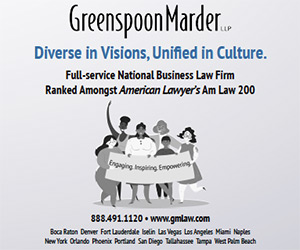EMPOWERING WOMEN IN THE WORKPLACE
PATENT LAWYER STANDS OUT FROM THE CROWD
In a male dominated world of patent litigation, Lauren Degnan stands out from the crowd. She has built an impressive reputation as a go-to litigator for leading high tech companies that need to protect and enforce their intellectual property assets.
As a principal with Fish & Richardson, she has experience litigating in district and federal court, at the ITC, and before the PTAB. She is also deeply committed to supporting women in their careers. Degnan is a member of the Washington, D.C. Advisory Board for the Women in Law Empowerment Forum, a national organization dedicated to helping women in law achieve their career goals. She is also an active member in Chiefs in Intellectual Property, a nonprofit dedicated to advancing women at the confluence of law, technology, and regulatory policy.
She has represented many leading hightech companies – including Microsoft, Arista Networks, Thomas Swan & Co., Intel, SIRIUS XM Radio, TomTom, and Samsung – involved in high-stakes, highrisk litigation where hundreds of millions of dollars, and often entire businesses, are on the line.
In the words of Lauren Degnan:
What barriers are in the way to closing the gender gap in STEM?
“STEM jobs are hard work. Women in STEM positions are smart, driven, accomplished, and generally all-around awesome. Women in STEM need to feel valued and supported, and see a clear path for advancement. Otherwise, they will opt out, especially if they have family commitments, given the societal pressures on women to be primary caregivers.”
How can the world increase diversity in STEM fields?
“First, work to ensure a consistent pipeline of qualified women who want to work in STEM by encouraging girls from a young age and through high school and college to have an interest in math and science and giving them the opportunity to succeed and have fun in the field. Second, work to keep women engaged in a STEM career after they are bitten by the technology bug by providing meaningful support during all phases of their careers. Such support, which should be tailored to the needs of each individual, includes coaching, mentorship, sponsorship, and a support network.”
What can be done to move women forward in STEM?
“First, coach people on how to counteract any unconscious biases. Second, establish policies requiring organizations, teams, and managers to make sure the pool of people considered for projects, assignments and promotion always include women. Third, avoid tokenism – for example, the tendency to stop trying to promote women once the organization already has one, or a few, in key positions.”
Where do you see women in STEM in five years?
“I think that, as a culture, we are on the right track.”
Words I live by:
“Do unto others as you would have them do unto you.”







